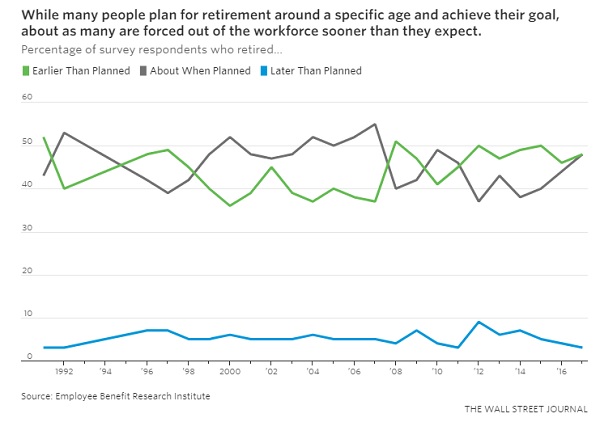The best-laid retirement plans
take into account investment-return assumptions and withdrawal rates. They
should also include planning for unexpectedly early departures from the
workforce.
While an increasing number of
Americans say they want to remain on the job after age 65, between 37% and 52%
of retirees polled annually since 1991 by the Employee Benefit Research
Institute say they left work before they had intended—often due to a health
issue or job loss.
As a result, individuals should
prepare for the possibility of an early retirement as part of their overall
planning. Steps to take include amassing three to six months’ pay in an
emergency fund and securing disability insurance, says Anna Rappaport, chairwoman
of the Society of Actuaries’ Committee on Post-Retirement Needs and Risks.
Those facing an imminent
departure also should focus on decisions about health insurance and any
severance pay or disability insurance they qualify for. Here’s a guide to those
decisions.
Health Insurance
If you leave your job when you
are 65 or older and don’t have another job with health insurance lined up, the
decision about how to replace your health insurance is simple: Before your
employer-sponsored coverage lapses, contact Social Security and sign up for
either original fee-for-service Medicare or a Medicare Advantage plan, which is
a health-maintenance or preferred-provider organization that contracts with
Medicare.
Those under 65 must look
elsewhere for coverage. Possibilities include joining a spouse’s plan, buying
coverage under the Affordable Care Act, or remaining on a former employer’s
plan under Cobra, a federal law that requires companies with 20 or more
employees to permit former workers to stay enrolled in the health plan,
typically for up to 18 months.

Cobra can be expensive. That’s
because while many employers subsidize workers’ premiums while they are
employed, they often require those on Cobra to pay the entire cost plus a 2%
annual administrative fee, says Juliette Cubanski, associate director of the
Kaiser Family Foundation’s Program on Medicare Policy.
With an ACA policy, individuals
with incomes of up to $47,520 and couples earning up to $64,080 may be eligible
for tax credits that cap their premiums on a benchmark plan—designed to cover
70% of medical expenses—at between 2% and 9.5% of income.
If you are using either Cobra or
an ACA policy, switch to Medicare once you turn 65, Ms. Cubanski says. If you
don’t make the move in the three months before or after your 65th birthday,
you‘ll have to wait until the beginning of the following year to sign up—and
your coverage won’t go into effect until July 1. For each year you wait to sign
up, you will pay an annual penalty of 10% of your premium under Medicare Part
B, which covers doctor visits, and about 12% of your Medicare Part D premium.
Severance
Companies frequently offer
severance to employees they lay off. One or two weeks of pay for every year of
employment up to a cap, such as 26 weeks, is typical, says Christopher
D’Angelo, an employment lawyer in New York at Michelman & Robinson LLP.
Some firms also include outplacement services or bonus pay for the portion of
the year an employee was on the payroll.
If you feel your employer is
pressuring you to quit, you may have some leverage to negotiate severance, says
Ms. Rappaport.
In contrast, those subject to a
mass layoff typically have little leverage to bargain unless they band together
or have “a strong legal claim,” says Mr. D’Angelo, citing someone who recently
filed a sexual-harassment claim.
Because companies pay severance
only after employees sign waivers releasing them from legal claims, an employer
might be willing to pay more severance to encourage someone with such a claim
to waive the right to pursue it.
Before accepting severance, have
an employment attorney review the agreement, says Ms. Rappaport. The Age
Discrimination in Employment Act gives those subject to layoffs involving more
than one employee up to 45 days to consider a severance offer—and confer with
an attorney—plus seven days after signing in which to revoke that decision.
Unless you have complex issues,
total costs for an employment attorney are likely to range from $1,000 to
$5,000, says Mr. D’Angelo.
Disability Insurance
If you become disabled, you may
qualify for benefits under an insurance policy or a government program.
Many employers offer free
short-term disability coverage for up to 90 days as part of a benefits package.
Some also provide long-term coverage or allow employees to buy it at a
discounted rate to help plan for the possibility of early retirement due to disability.
(Individuals also can buy coverage directly from insurance companies.)
Long-term disability policies
typically pay 50% to 60% of a disabled employee’s salary, says Mike Stein,
assistant vice president at Allsup, a Belleville, Ill., company that represents
people filing disability claims.
To collect, you have to meet your
policy’s definition of being disabled. “It’s not uncommon to see policies that
say, ‘We will pay you if you are unable to do your former job for the first two
years and after that, we will continue to pay you only if you cannot do any
work,’” says Mr. Stein.
If you paid Social Security taxes
for 20 of the past 40 quarters, you may qualify for Social Security Disability
Insurance if your disability is expected to last at least a year or result in
death. (Supplemental Security Income is a separate program for low-income
people with disabilities.)
If you qualify for both SSDI and
private disability insurance, file for both, Mr. Stein says. Generally, your
insurer will reduce your policy’s benefits by the amount of your SSDI, says Mr.
Stein.
SSDI often adjusts its payments
annually for inflation and allows recipients to file for Medicare after two
years, among other benefits.
Click
here for the original article from Wall
Street Journal.